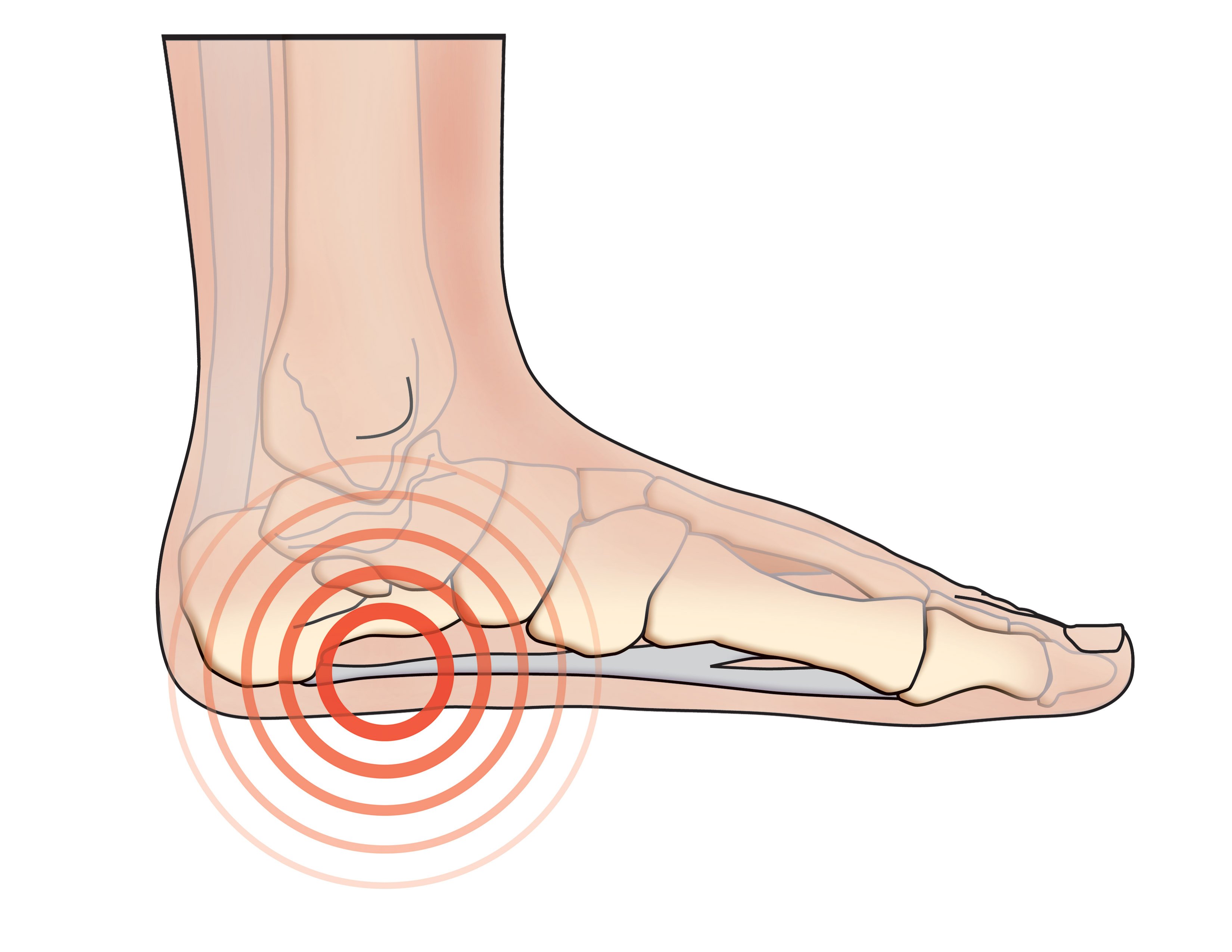Plantar Fasciitis (Heel Pain) Treatment, Symptoms, Causes, and Prevention
Plantar fasciitis is a common ailment involving the inflammation of a thick band of tissue, the fascia, that links the toes to the heel bone underneath your foot. It often includes a sharp pain on or near the heel.
Two Types of Plantar Fasciitis
Acute Plantar Fasciitis: The condition is brought on by an injury.
Chronic Plantar Fasciitis: The more typical of the two, this is when the onset of plantar fasciitis cannot be linked to a particular event, but gradually worsens over time.
Both types are often associated with flat feet or a flat foot, whether the individual has had this condition their entire life or not.

Plantar Fasciitis Symptoms
Is plantar fasciitis painful?
Typically, yes. The pain tends to be in the back of the foot near the heel, on the bottom of the foot.
Do you think that you have plantar fasciitis? Please read below to see if you have any of the other symptoms.
- Stabbing pain in the bottom of the foot, close to the heel
- Pain is particularly worse when taking the first few steps of the day
- Discomfort can worsen due to long periods of sitting or standing
- Experiencing pain after exercising
- Irritation in the middle of the foot, plantar heel pain
- Soreness in one or both feet
- Burning sensation may also be experienced
- Heel stiffness
- High arch or flat feet
What is the Difference Between Plantar Fasciitis vs Gout vs Heel Spur?
Pain in the heel or bottom of the foot can be caused by several different factors. See how the different ailments compare.
What is plantar fasciitis?
Plantar fasciitis occurs when a thick band of tissue across the bottom of the foot becomes inflamed and feels painful. It is generally felt in the heel or sometimes sole of the foot. It affects the ligaments of the foot.
What is gout?
Gout is a type of arthritis, and is distinguished by tenderness, redness, and pain in the joints. It can occur in any of the bodies’ joints, unlike plantar fasciitis, which occurs in only the fascia ligaments.
What is a heel spur?
Heel spurs also tend to cause pain, but the pain is from a bony growth on the heel bone, not from ligament tissue underneath the arch of the foot.
Plantar Fasciitis Causes
How do you get plantar fasciitis?
It is most often a result of the ligament fascia on the sole of the foot being repetitively strained. The strain leads to small tears in the fascia, near the heel of the foot.
Common Causes of Plantar Fasciitis
- Foot layout, such as flat feet or a flat foot, a high arch, or an uneven distribution of weight when walking or standing
- Weight gain or obesity
- Shoes with low arch support
- Age, occurring most often in people between the ages of 40 and 70
- Pregnancy, particularly during the third trimester
- Tight Achilles tendons
- Exercising, such as certain types of dancing, like ballet and aerobics, or long-distance running
Plantar Fasciitis Prevention
How to prevent plantar fasciitis?
- Before playing sports or working out, make sure to stretch properly. This includes stretching the Achilles tendon in your heel. If you did a particular grueling workout, ice the bottom of your foot to prevent damage.
- Wear shoes with good arch support and replace your athletic sneakers on a regular basis. Use PediFix® orthotic devices in shoes or while resting at home.
- Avoid shoes with too soft insoles or no arch support.
- Apply a PediFix® Plantar Fasciitis product from the suggested products below. They can help prevent symptoms from occurring or worsening.
Plantar Fasciitis Exercises & Treatment
How To Treat Plantar Fasciitis?
If you believe you have plantar fasciitis, contact your doctor or podiatrist as soon as possible. Typically, people recover in a few months from flat feet pain by resting, rehabilitation, stretching, and icing.
There are many exercises to try to help plantar fasciitis. One is a gentle stretch against the wall. Place your hands against the wall, step back with the injured foot, and hold this stretch for 15 to 30 seconds. Repeat this three times on both feet.
Another stretch to do is place a towel on the floor, and bunch it up together using your toes. Then unbunch it. Do this for a minute, curling your toes 10 times, then stretching them out 10 times.
When icing, do so in increments of 15-20 minutes, with the foot above the heart, for best results.
Recommended PediFix® Plantar Fasciitis Solutions:
Apply a PediFix® plantar fasciitis product from the selection below. Many of these products can help reduce pain, inflammation, and irritation in your foot. (Products found on the website when searching for plantar fasciitis or flat feet, in alphabetic order)
- Action Orthotics™ 3/4 Length Arch Supports (#P5610)
- Active Orthotics™ 3/4-Length Firm Support Insoles (#P5300)
- Active Orthotics™ Full-Length Firm Support Insoles (#P5350)
- Advantage Orthotics™ 3/4-Length Carbon Graphite Arch Supports (#P4860)
- Arch Cradles® (#P182)
- Arch Support Bandages (#P60)
- Arch Support Bandage with Metatarsal Pad (#P6002)
- Cold Therapy Socks (#P705)
- EZ Mornings™ Heel Relief Stretching Splint (#P6040)
- FasciaFix® Plantar Fasciitis Relief Sleeve (#P6023)
- FELTastic® Arch Pads (#P8536)
- FELTastic® Heel Pads (#P8534)
- FELTastic® Metatarsal Support Pads (#P86)
- Pedi-Smart® Arch Brace (#P61)
- Plantar Fasciitis Relief Strips (#P6060)
- QuickTape® Support Straps (#P6065)
- Visco-GEL® Arch Support Wrap (#P1291)
- Visco-GEL® Plantar Fasciitis Arch Support Sleeve (#P1450)





